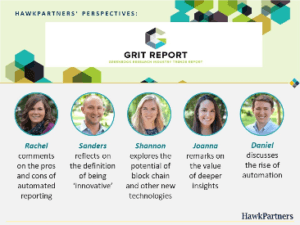Each year, Greenbook releases its Annual Greenbook Research Industry Trends (GRIT) Report outlining emerging trends in the research space. As a research and consulting firm, HawkPartners is uniquely positioned as a partner to many of the companies in the report, with some of our best clients featured for the innovative work they’re doing in the marketplace, and some of our suppliers who are revolutionizing the technologies and platforms we use daily.
Most importantly, though, it provides everyone who touches the market research world an opportunity to see where we’re headed. This year, we asked our team to go through the report and respond to the simple question, “What gets you most excited about the future of the research industry?” Here’s a sampling of what we found:

“Market researchers are often challenged to produce high-quality visuals within our deliverables, while also providing results and strategic insights quickly. While this has been a challenge the industry has faced for many years, the emergence of automated reporting tools opens new possibilities. With the ability to have charts and tables created quickly and accurately, market researchers and consultants will be able to allocate more time to digging into the findings, pulling out key pieces of information, and making strategic recommendations while still crafting high-level, succinct, visual representations of the findings. While automated reporting tools will not replace the need for research partners to visually represent key findings, they will allow for deliverables that look better overall, are completed quicker, and include more strategic analysis.”
“In the age of automated bots and dwindling attention spans, we’re constantly testing new ways to verify survey respondents and to keep engagement high. What’s interesting in the GRIT report is that while optimism for the future of sample quality is trending down among researchers surveyed, the report itself incited positivity for the future. Blockchain technology, for example, offers promising applications for data validity/authenticity, as well as assuaging rising concerns pertaining to data privacy for respondents. In the more immediate future, survey fatigue and declining engagement is forcing the industry as a whole to test more creative, innovative survey methods. In my view, the future of research is looking up for respondents and researchers alike.”
“I’m excited that the industry is continuing to value deeper insights that drive strategy for the business as a whole. The vision that clients have for what types of firms add value aligns really well with our use of advanced analysis coupled with a holistic understanding of our clients’ businesses. For a while, we’ve talked about that as what makes us different as a firm, so to see it reaffirmed by clients is very exciting!”
“I find the difference between how consumers and research firms view innovation incredibly interesting, as we saw some new names on the list of most innovative companies. As clients/suppliers work with these companies, they gain insight into what truly makes them innovative, such as development of new products, delivery mechanisms and technologies. I’m really excited about the prospect of helping companies like these, who are clearly doing innovative things, to build their brand reputations to reflect that.
Daniel Sargent:
“Market research firms are increasingly turning to automation services for survey design, project planning and infographics. These innovative charting and analytics platforms allow researchers to manipulate data and create visually-engaging reports with greater speed and accuracy. The rise of automation may seem like a threat to some firms, but savvy companies will view new technologies as assets in the researcher’s toolkit. Automated data analysis will free researchers from labor-intensive tasks, reduce costs and ultimately allow them to focus on leveraging insights to drive meaningful impact for their clients.”
